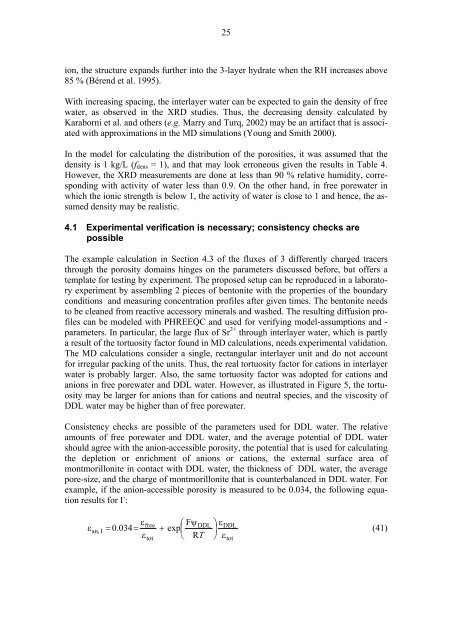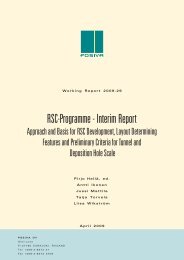A review of porosity and Diffusion in Bentonite (pdf) (2.4 MB) - Posiva
A review of porosity and Diffusion in Bentonite (pdf) (2.4 MB) - Posiva
A review of porosity and Diffusion in Bentonite (pdf) (2.4 MB) - Posiva
Create successful ePaper yourself
Turn your PDF publications into a flip-book with our unique Google optimized e-Paper software.
25ion, the structure exp<strong>and</strong>s further <strong>in</strong>to the 3-layer hydrate when the RH <strong>in</strong>creases above85 % (Bérend et al. 1995).With <strong>in</strong>creas<strong>in</strong>g spac<strong>in</strong>g, the <strong>in</strong>terlayer water can be expected to ga<strong>in</strong> the density <strong>of</strong> freewater, as observed <strong>in</strong> the XRD studies. Thus, the decreas<strong>in</strong>g density calculated byKaraborni et al. <strong>and</strong> others (e.g. Marry <strong>and</strong> Turq, 2002) may be an artifact that is associatedwith approximations <strong>in</strong> the MD simulations (Young <strong>and</strong> Smith 2000).In the model for calculat<strong>in</strong>g the distribution <strong>of</strong> the porosities, it was assumed that thedensity is 1 kg/L (f dens = 1), <strong>and</strong> that may look erroneous given the results <strong>in</strong> Table 4.However, the XRD measurements are done at less than 90 % relative humidity, correspond<strong>in</strong>gwith activity <strong>of</strong> water less than 0.9. On the other h<strong>and</strong>, <strong>in</strong> free porewater <strong>in</strong>which the ionic strength is below 1, the activity <strong>of</strong> water is close to 1 <strong>and</strong> hence, the assumeddensity may be realistic.4.1 Experimental verification is necessary; consistency checks arepossibleThe example calculation <strong>in</strong> Section 4.3 <strong>of</strong> the fluxes <strong>of</strong> 3 differently charged tracersthrough the <strong>porosity</strong> doma<strong>in</strong>s h<strong>in</strong>ges on the parameters discussed before, but <strong>of</strong>fers atemplate for test<strong>in</strong>g by experiment. The proposed setup can be reproduced <strong>in</strong> a laboratoryexperiment by assembl<strong>in</strong>g 2 pieces <strong>of</strong> bentonite with the properties <strong>of</strong> the boundaryconditions <strong>and</strong> measur<strong>in</strong>g concentration pr<strong>of</strong>iles after given times. The bentonite needsto be cleaned from reactive accessory m<strong>in</strong>erals <strong>and</strong> washed. The result<strong>in</strong>g diffusion pr<strong>of</strong>ilescan be modeled with PHREEQC <strong>and</strong> used for verify<strong>in</strong>g model-assumptions <strong>and</strong> -parameters. In particular, the large flux <strong>of</strong> Sr 2+ through <strong>in</strong>terlayer water, which is partlya result <strong>of</strong> the tortuosity factor found <strong>in</strong> MD calculations, needs experimental validation.The MD calculations consider a s<strong>in</strong>gle, rectangular <strong>in</strong>terlayer unit <strong>and</strong> do not accountfor irregular pack<strong>in</strong>g <strong>of</strong> the units. Thus, the real tortuosity factor for cations <strong>in</strong> <strong>in</strong>terlayerwater is probably larger. Also, the same tortuosity factor was adopted for cations <strong>and</strong>anions <strong>in</strong> free porewater <strong>and</strong> DDL water. However, as illustrated <strong>in</strong> Figure 5, the tortuositymay be larger for anions than for cations <strong>and</strong> neutral species, <strong>and</strong> the viscosity <strong>of</strong>DDL water may be higher than <strong>of</strong> free porewater.Consistency checks are possible <strong>of</strong> the parameters used for DDL water. The relativeamounts <strong>of</strong> free porewater <strong>and</strong> DDL water, <strong>and</strong> the average potential <strong>of</strong> DDL watershould agree with the anion-accessible <strong>porosity</strong>, the potential that is used for calculat<strong>in</strong>gthe depletion or enrichment <strong>of</strong> anions or cations, the external surface area <strong>of</strong>montmorillonite <strong>in</strong> contact with DDL water, the thickness <strong>of</strong> DDL water, the averagepore-size, <strong>and</strong> the charge <strong>of</strong> montmorillonite that is counterbalanced <strong>in</strong> DDL water. Forexample, if the anion-accessible <strong>porosity</strong> is measured to be 0.034, the follow<strong>in</strong>g equationresults for I - :an, Ifree FDDL DDL 0. 034 exp(41) RT tottot
















